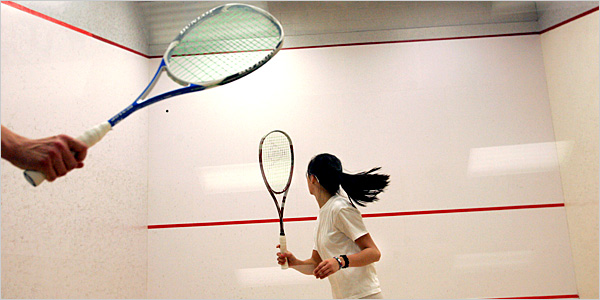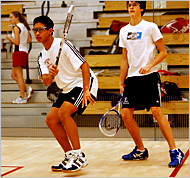

TAKE THAT A teenager practicing at a Manhattan club
with her coach.
YOU’VE already enrolled your teenagers in advanced-placement Mandarin, retained a $9,000-a-year college admissions consultant to help refine their applications, and sent them off to Kyrgyzstan to dig irrigation ditches for the summer. Still, there’s no guarantee that they’ll get into an Ivy League university. What are you going to do?

A BOOM IN SQUASH
Kevin Chen, left, and David Rabin at Phillips Exeter Academy,
which is adding new courts.
Like a small but growing number of parents, you might hand the kids squash rackets.
In an era of increasingly competitive college admissions — when Princeton, for example, turns down four of five valedictorians who apply — anxious parents are looking for some edge, any edge, to help their child gain entry through the back door of the nation’s most selective universities.
Squash, an indoor racket sport long associated with private clubs and old-boy networks, is so esoteric that it barely qualifies as a back door. In terms of the number of actual spots on college rosters, it might be more of a pet door.
Still, a high percentage of the nation’s most prestigious colleges field teams. Squash pros and coaches say that in the last few years the sport has seen a sharp increase in participation by children and teenagers, some of whose parents seem to have one eye on the ball and the other on college applications.
“Squash is ‘hot’ right now,” said Kenny Scher, the executive director of the New York-based Metropolitan Squash Racquets Association, which organizes leagues and tournaments.
US Squash, the sport’s governing body in this country, has tracked a 20 percent spike in membership among players under 18 over the last two years. “It’s generally known out there that parents are pushing their kids more” because of academic ambitions, Mr. Scher said. “You just hear about it more. They’re taking more lessons, they’re spending more money.” (Private lessons run about $80 an hour, plus court time.)
But why squash?
Parents, Mr. Sher said, like the idea “that not everybody can play it, not everyone can afford it — it’s almost like it’s a more upscale product.”
IN an e-mail message, Gail Ramsay, the women’s squash coach at Princeton, confirmed that there are many opportunities for good high-school players. “Not only do the eight Ivy League schools — Columbia will turn varsity in 2011 — have teams, but there are another 21 of the top liberal arts schools that also recruit from this pool of squash players,” Ms. Ramsay wrote. “I actually feel there are not enough players to fill those recruiting spots each year.”
Parents of squash players tended to be guarded when asked by a reporter about any careerist aspects of their children’s squash lessons. (Q: When are parents not thrilled to discuss their children’s athletic endeavors? A: When they think it might reveal the trump card that could get their kid into Dartmouth.)
College is not the only reason the game is enjoying a youth boom. In recent years, squash leagues and tournaments have become more welcoming to intermediates and novices, said Kevin Klipstein, the chief executive of US Squash. Proponents have also managed to sell the sport’s appeal outside its traditional preppy demographic. Several private clubs in New York have opened their courts to teams of young people from the inner city.
Besides, it’s fun. But back to the competitive sport known as getting into college.
“It’s no different from playing violin,” said Lise Chapman, a mother of two squash-playing children in Short Hills, N.J. “Extracurricular activities, they all enhance your application.”
Still, it’s not violin cases that kids are carrying around hotbeds of parental ambition like Brooklyn Heights (home of the Heights Casino, a private athletic club and renowned squash factory) or Greenwich, Conn. Rather, it is the long, skinny squash racket — once as incongruous on a 10-year-old as a tweed jacket.
“I’ve noticed in the last year, talking to people in Greenwich, that it seems like there are more squash players than tennis players now,” said Lisa Matthews, a mother of three boys in that town who have all taken up squash.
Her eldest son, whom she declined to name, leveraged his squash skills to help him earn admission recently to Princeton, which has fueled the ambitions of his younger brothers, she said.
“It’s a wonderful benefit,” Ms. Matthews said. “It just helps your admissions chances.”
The idea that squash is a shoo-in sport is debatable, said some admissions experts.
David Petersam, founder of AdmissionsConsultants in Vienna, Va., acknowledged that colleges consider extracurricular activities, but, he added, “to say squash is better than basketball, baseball or Greco-Roman wrestling, I wouldn’t go that far.”
Unlike basketball or Greco-Roman wrestling, however, squash does enjoy a prestige that some think makes it attractive to college admissions boards. With roots in the English public schools of the 19th century, squash conveys an aristocratic quirkiness, a bit like a taste for Sanskrit poetry. More than its preppy cousins lacrosse and rowing, it is also considered a cerebral sport — chess in short pants.
But more important, squash, until recently, has been almost exclusively a sport of elite schools in the Northeast. Harvard, Princeton and Yale are traditional powerhouses. The number of schools with men’s intercollegiate varsity or club teams registered with the College Squash Association is currently 65, with 22 of them emerging in just the last few years.
And even as squash spreads, it is often embraced by other academically selective universities, including North Carolina, Georgetown, Vanderbilt, Notre Dame and even small Kenyon College in Ohio. There are now 34 women’s teams; Stanford fielded its first varsity women’s squad last year.
“If you look at a list of colleges that have squash,” said Ramsay Vehslage, the varsity squash coach at the Pingry School, a prep school in Martinsville, N.J., “there isn’t a bad school on the list.”
In addition, talented players at the high school level enjoy relatively favorable prospects of playing in college compared to more popular sports.
“Because there are so many college programs growing out there, it’s just supply and demand,” said Robby Berner, 18, who was recruited to play on Yale’s team after graduating from the Brunswick School in Greenwich this year. “You don’t have to be a star coming out of high school.”
Squash skills can also help students get into the selective prep schools that are feeder schools for top universities. Kirk Randall, the varsity boys and girls squash coach at Phillips Exeter Academy in Exeter, N.H., said his school had recently christened 10 new squash courts, financed by alumni, and another six on the way.
And yes, Exeter recruits. “We do have contact with our admissions people,” Mr. Randall said, “and we do try to put in a plug for the kids we’d like to have here, as long as academically qualified.”
Advocates of the sport say that squash is still obscure enough that the talent pool is on the shallow side.
“I’ve had lots of kids who pick up squash in ninth grade and become nationally ranked by the time they apply,” said Michele Hernandez, founder of Hernandez College Consulting in Weybridge, Vt. “I can’t think of another sport where they can start so late.”
Then again, with the numbers of squash players as young as 8 swelling, parents are concerned that they might already have missed the moment.
ONE New York parent of a squash-playing daughter pointed out that college squash scholarships were still rare, vacancies few — often no more than a few freshmen on a squad — and players from squash hothouses like the Middle East and South Asia tended to fill many of those.
It’s to the point, he said, where the last undiscovered college sport seems to be bowling.
In other words, if you’re a parent worried about admissions, you might consider reserving your lane now.